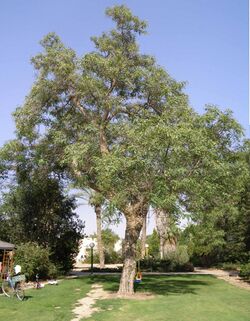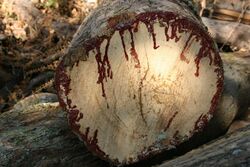Biology:Tipuana
| Tipuana | |
|---|---|

| |
| Tipuana tipu, Revivim, Israel | |

| |
| Flowers | |
| Scientific classification | |
| Kingdom: | Plantae |
| Clade: | Tracheophytes |
| Clade: | Angiosperms |
| Clade: | Eudicots |
| Clade: | Rosids |
| Order: | Fabales |
| Family: | Fabaceae |
| Subfamily: | Faboideae |
| Tribe: | Dalbergieae |
| Genus: | Tipuana Benth. |
| Species: | T. tipu
|
| Binomial name | |
| Tipuana tipu (Benth.) Kuntze
| |
| Synonyms | |
| |
Tipuana tipu, also known as tipa,[2] rosewood and pride of Bolivia, is a South American tree.
Taxonomy
It is the only member of the genus Tipuana.[3][4] It was recently assigned to the informal monophyletic Pterocarpus clade within the Dalbergieae.[5][6]
Physical characteristics
Depending on where it is grown, Tipuana is largely a deciduous tree, annually shedding all or most of its leaves and large "helicopter" pods from midwinter to spring.[citation needed] It produces masses of seeds, most of which succeed in germinating, and it can withstand a very wide range of growing conditions, from −4 °C (25 °F) to salty soils to drought.[7] Timber is whitish in color, strong and fibrous.[citation needed]
Invasiveness
Tipuana tipu is viewed as an invasive weed in some countries and is known for having a very aggressive root system.[8] The tree roots can easily lift up concrete and asphalt. Precautions should be taken when planting near buildings, homes, or pools, as they are likely to be damaged. Damage may sometimes be averted by trenching near the structure to a depth of about 1 metre and filling the trench with building rubble or lining the trench with thick plastic sheeting or corrugated roofing sheets.
It is listed as a Category 3 Invasive species in South Africa.[9] Category 3 species are regarded as having the proven potential of becoming invasive, and are not allowed to occur anywhere except in biological control reserves, unless they were already in existence when the regulations went into effect. The conditions on which these already existing plants may be retained are that they do not grow within 30 m from the 1:50 year flood line of watercourses or wetlands, that all reasonable steps are taken to keep the plant from spreading, and that the Executive Officer has the power to impose additional conditions or even prohibit the growing in any area where he has reason to believe that these plants will pose a threat to agricultural resources. Propagative material of these plants, such as seeds or cuttings, may no longer be planted, propagated, imported, bought, sold or traded in any way. It will, however, be legal to trade in the wood of Category 3 plants, or in other products that do not have the potential to grow or multiply.[10]
Insects
The species is a food plant for spittlebugs such as Ptyelus grossus. In Southern California, an insect called tipu psyllid (Platycorypha nigrivirga) has invaded several trees.[11] In South Africa (Knysna) Tipuana is attacked by polyphagous shot hole borer (Euwallacea fornicatus).
References
- ↑ Botanic Gardens Conservation International (BGCI) & IUCN SSC Global Tree Specialist Group. 2019. Tipuana tipu. The IUCN Red List of Threatened Species 2019: e.T62028299A149012636. https://dx.doi.org/10.2305/IUCN.UK.2019-2.RLTS.T62028299A149012636.en. Accessed on 28 March 2023.
- ↑ "Tipuana tipa". Natural Resources Conservation Service PLANTS Database. USDA. https://plants.usda.gov/core/profile?symbol=TITI2.
- ↑ "ILDIS LegumeWeb entry for Tipuana". Cardiff School of Computer Science & Informatics. http://www.ildis.org/LegumeWeb?version~10.01&genus~Tipuana&species~.
- ↑ USDA; ARS. "GRIN species records of Tipuana". National Germplasm Resources Laboratory, Beltsville, Maryland. http://www.ars-grin.gov/cgi-bin/npgs/html/splist.pl?12163.
- ↑ "The dalbergioid legumes (Fabaceae): delimitation of a pantropical monophyletic clade". Am J Bot 88 (3): 503–33. 2001. doi:10.2307/2657116. PMID 11250829.
- ↑ "Reconstructing the deep-branching relationships of the papilionoid legumes". S Afr J Bot 89: 58–75. 2013. doi:10.1016/j.sajb.2013.05.001.
- ↑ "2006 | SERIES 17 | Episode 11 - Fact Sheets - Gardening Australia - GARDENING AUSTRALIA". 29 April 2006. http://www.abc.net.au/gardening/stories/s1625878.htm.
- ↑ http://www.weeds.gov.au/publications/guidelines/alert/t-tipu.html [|permanent dead link|dead link}}]
- ↑ "What does the law say? – Invasive Species South Africa". http://www.invasives.org.za/legislation/what-does-the-law-say.
- ↑ http://www.arc.agric.za/arc-ppri/Pages/Weeds%20Research/Legal-obligations-regarding-invasive-alien-plants-in-South-Africa-.aspx
- ↑ University of California, Riverside, Center for Invasive Species Research.
Wikidata ☰ {{{from}}} entry
 |



